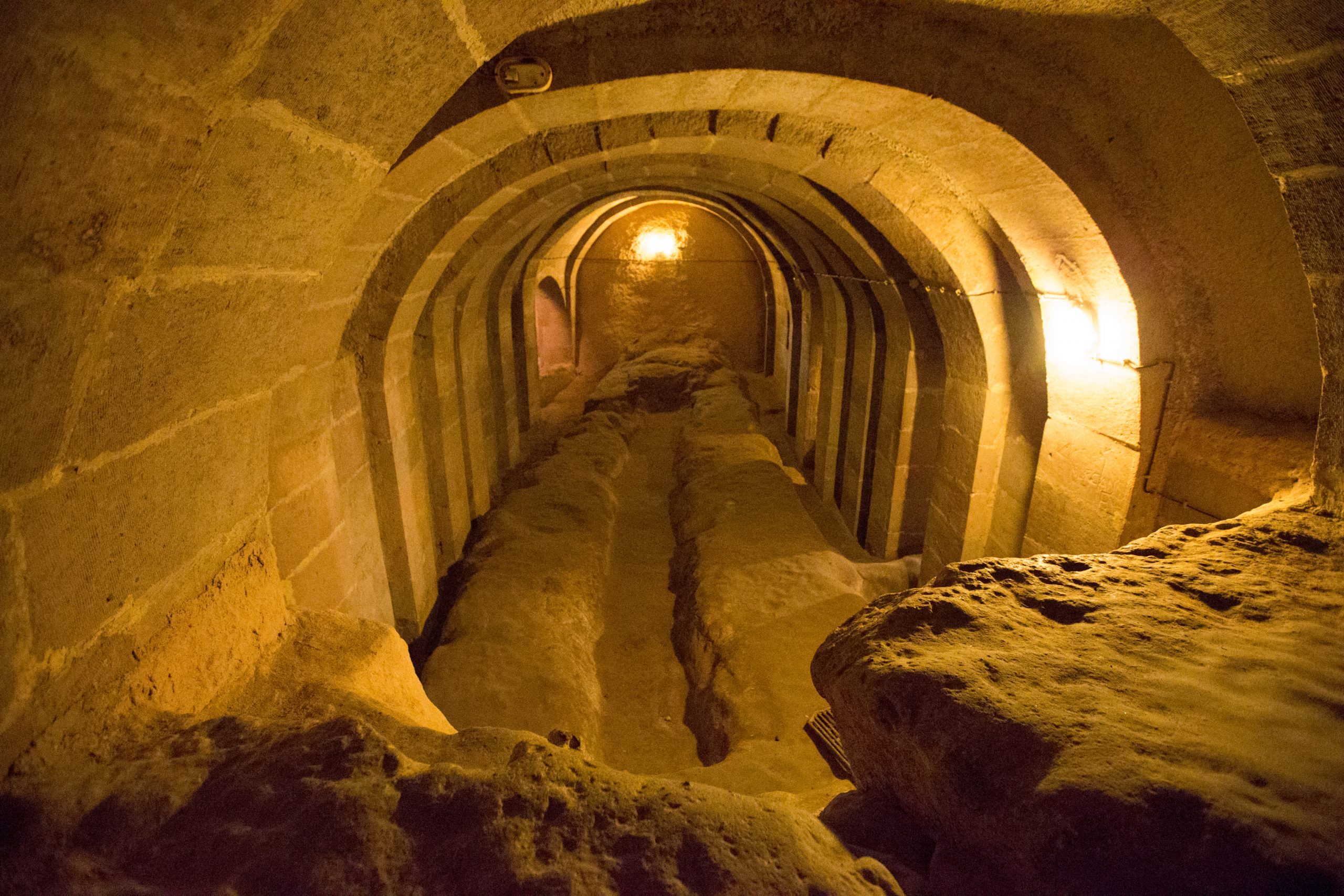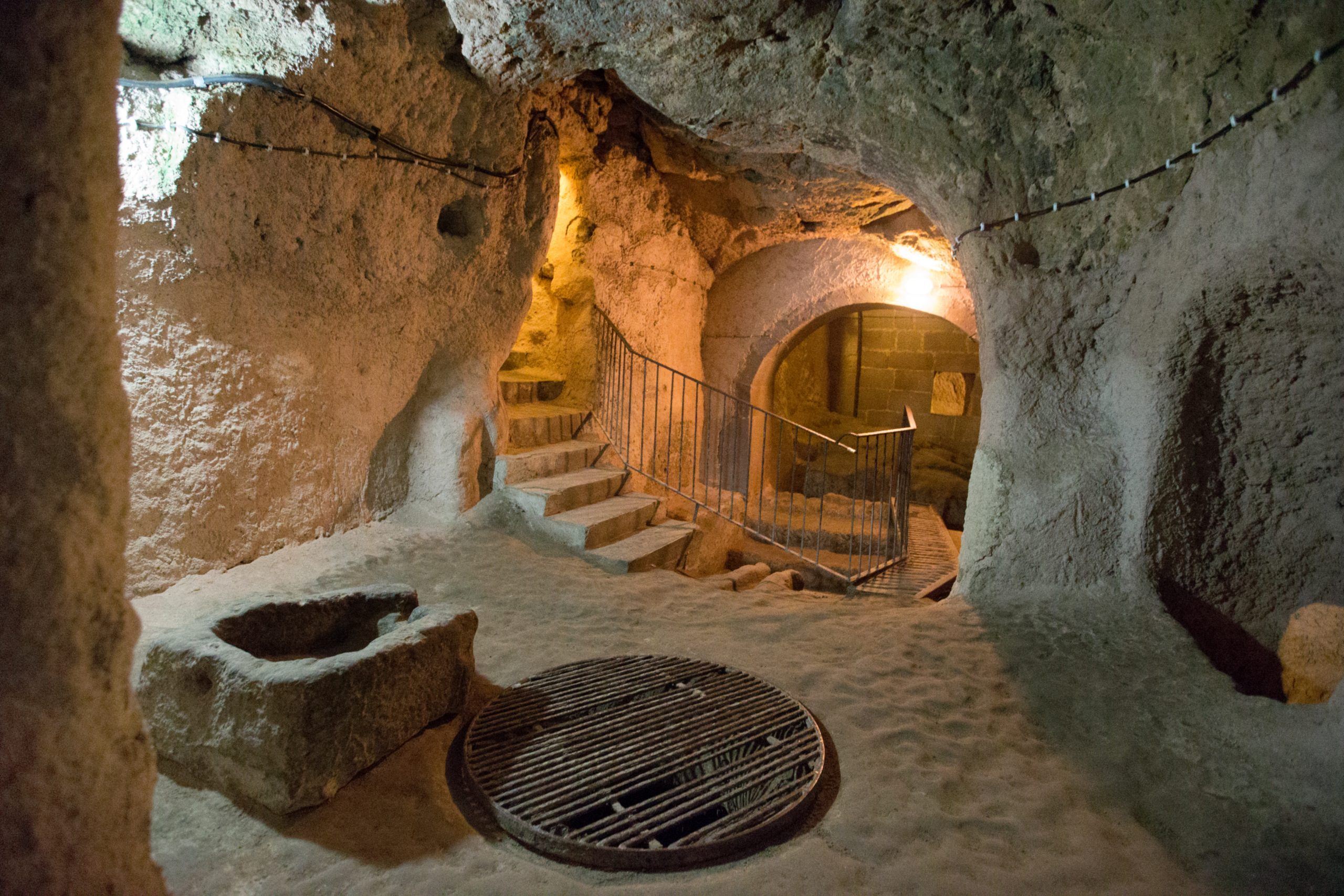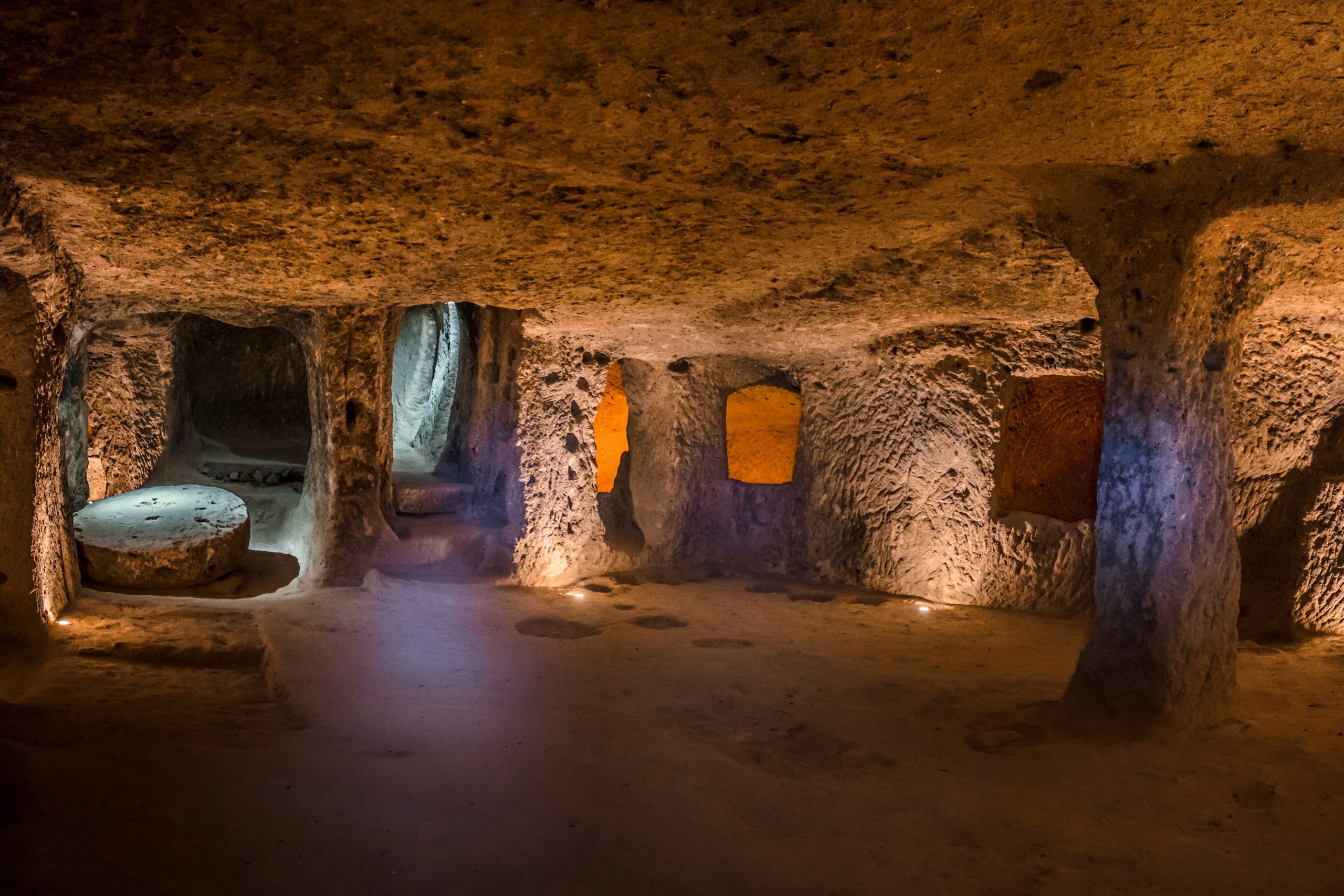Ozluce Underground City
Ozluce Underground City; ‘Zeile’ in the Middle Ages, or Özlüce as it is known today, is an underground city located on the Nevşehir-Derinkuyu line and 6 kilometers away from the town of Kaymaklı. Özlüce village, like many villages in Cappadocia, is a Greek village. Özlüce Underground City entrance is located in the center of this village.
Nevşehir Ozluce Village was one of the centers considered sacred during the Persian rule. Even BC. This village, which has been used as a settlement since the 4th century, was known as ‘Zela’ in the Persian period. In Strabo’s work called Geography, it is said that Zela belongs to the three Persian gods Anaitis, Omanos and Anadates.
Özlüce is one of the villages with the largest Greek population in the Cappadocia region. This village, where the Turkish population was not even allowed to reside before the population exchange, is one of the few regions where the Greek population is concentrated. Another important historical monument in Özlüce Village is the Church of the Holy Apostles. After the population exchange, this church was converted into a mosque by adding a minaret and mihrab during the reign of Abdülmecid I. The destroyed bell tower is known to have collapsed. In addition to these, decorations, crosses and frescoes have been preserved until today.

Ozluce Underground City Architecture
The main space of Ozluce Underground City, located at the entrance of the underground city, is the largest area of this city. There are storage rooms, rooms and partitions around a long gallery. The traps on the floors of the rooms were considered as a defense method against the enemies. The main detail that stands out in the architecture is that the underground city, unlike other cities, consists of long galleries and shows a horizontal expansion. With this feature, it differs from other cities that have a floor system.
Ozluce Underground City consists of tuffs of different colors. The granite keystone with a diameter of 2 meters has been preserved until today. After passing the keystone, you can reach the carved places of the city by following a 15-meter tunnel. It is known that the stones at the entrance of the underground city are newer than the stones in the main tuff rock. The main tuff rock ends with a granite bolt stone with a diameter of 1.75 meters. The area, which is considered as the main space, consists of two parts. On the right side of the space there are storage warehouses, while on the left side there are living rooms. The ceiling height of this city is higher than other underground cities. Therefore, it provides a more comfortable circulation opportunity.
Ozluce Underground City Today
Underground Cities and Features in Cappadocia
There are many features that make Cappadocia special and unique. However, the main feature that makes it valuable is that it has always maintained its importance in different time periods throughout history. Starting from the Assyrians, who taught humanity to trade, this region, which has continued to exist until today, continues to present us with the beauties it has collected from the civilizations it has lived.
Cappadocia carries traces of different religions and histories in every corner. It is also very important in this respect that the most beautiful and oldest churches belonging to Christianity are found in this region. The Cappadocia region has been the homeland and land of many Greeks until the time of the population exchange. With the arrival of Christianity in the lands of Cappadocia, the region gained a serious religious status. In the early periods when the Byzantine Empire banned the religion of Christianity and persecuted those who accepted this religion, Cappadocia became a center of refuge for the first Christians.
The Cappadocia region has been a ‘hideout’ center throughout history, due to its rugged terrain and the soft tuff layer that can easily take shape and form a chamber. The first information that early Christians learned about religion was given in these lands. It is possible to see the rooms of the priests who were in seclusion even today. This point, which has never lost its value, starting from its important status on the Silk Road throughout history, has been a key center for many civilizations. For this reason, it is an important region where wars and the love of seizing are experienced.
All these reasons allow us to understand the idea behind the abundance of underground cities. In cases where the rugged geological structure of the land was insufficient, the people living in this region built underground cities to protect themselves. The unique architecture of these underground cities, where it is possible to live for a long time, is still not fully understood even today.

Other Underground Cities in Cappadocia
There are many underground cities discovered in Cappadocia, such as the Özlüce Underground City. Many of these are open to visitors today. You can read the information we have prepared for you about the other cities that make up the underground wealth of the Cappadocia region in the continuation of our article.
The underground cities most visited by tourists are Derinkuyu and Kaymaklı. According to one estimation, the underground cities are all interconnected and it is possible to switch between them. These cities, which have been used for different purposes throughout history for shelter and defense, once again reveal the richness of Cappadocia.
Özkonak Underground City
Özkonak Underground City, located on the northern slope of İdiş Mountain, is considered one of the most important historical sites in the Cappadocia region. This underground city, built on the valley, which is dense in terms of tuff layer, has served different purposes throughout history. Cities were generally built to protect against invasions. It is almost as if they have established a secret civilization under the ground.
In this underground city, there is a thoughtful ventilation system that would make today’s ventilation systems jealous. Özkonak Underground City, built with 4 floors, can be thought of as an apartment hidden underground. We can also say that there are still spots waiting to be discovered in this underground city, which was opened after being cleaned in 1972. It is known that there is a distance of 10 kilometers between its entrance and exit. This gives us some information about how big the underground city is.
B.C. The difference of this city, which is estimated to have been built in the 400s, from other underground cities is the long and narrow holes made for communication. In addition, unlike other cities, the hunting holes in the entrance tunnels make Özkonak Underground City different from the others. These holes were also used in times of war for purposes such as throwing hot oil at the enemy or throwing spears. It can be said that this idea is a defensive measure of the underground cities.
Although there is a rumor that each house in Özkonak village has tunnels connected to this underground city, it gives us information about the advanced connection system. You can visit this underground city in Avanos and experience its unique beauty.
Kaymakli Underground City
Another historical underground city in the Cappadocia region is Kaymaklı Underground City. Built with 8 floors, this city is considered quite large among other underground cities. It contains nearly 200 underground cities with its huge bolt stones, corridors that are still unsolved.
B.C. It is estimated that the architects of the underground city, which is thought to have been built in 3000 BC, were Hittites. The underground city, which was enlarged by carving in the Roman and Byzantine periods, was used as an important hiding place in the wars.
There are wine stores, kitchens, ventilation, a church and water wells in this city, which contains many necessities for temporary shelter. All these sections were connected to each other by narrow tunnels, forming a large underground city. As in other underground cities, Kaymaklı Underground City was built by carving tuff rocks. You can visit Kaymaklı Underground City, which is open to visitors today, by paying an entrance fee of 75₺.

Derinkuyu Underground City
Derinkuyu Underground City, which is considered the most developed underground city in Cappadocia, has a depth of 85 meters and an 8-storey structure. Found by chance in 1963, this underground city takes its name from 52 drinking water wells at a depth of 60 meters. Located 30 kilometers from Nevşehir, this underground city has ventilation pipes going down to a depth of 55 meters.
It is known that a very small part of it is open to visitors today. It is estimated that Derinkuyu Underground City can reach 12-13 floors when the entire city is cleared. The fact that approximately 50 thousand people lived in these cities for a long time without going out is still unsolved.
Along with its ventilation system, kitchens, rooms, and water wells, this underground city also includes a missionary school, confessional, and baptismal pool. It is a city built by the first Christians to hide from Roman soldiers. It is a structure that is connected to each other by narrow tunnels that only a person can pass through. There are large stone cylinders used to ensure safety at the entrances and exits of the tunnels.
Thuja Underground City
It is an underground city located in Mazı Village, whose ancient name is ‘Mataza’. The underground city is located 18 kilometers south of Ürgüp. It is also located 10 kilometers east of Kaymaklı Underground City. It is known to have 4 entrances located in different locations. The underground city, which has 8 floors, is located on the steep slope on the west side of Mazı village.
The entrances of the underground cities were secured with large bolt stones as in other cities. In this city, where the ground floor belongs to the barns, the high number of barns suggests that the livelihood is livestock.
It is an underground city where about 6,000 people are thought to live. In the underground city, there is a church, winery, ventilation shafts and tunnels that follow different directions. A marvel of engineering and architecture, the city is suitable for long-term living with its connections and residential features. You can visit this underground city with an entrance fee of 12₺ in 2022.
Acıgöl Underground City
This structure, which is very similar to Özlüce Underground City in terms of architecture, has an architecture connected to each other by tunnels. The city, which was discovered in 1975, was opened to visitors in 1991. It has three known entrances. However, since the main entrance was destroyed, the city is now accessed from two entrances. It can be said that it is a magnificent structure with its arched spaces and carved partitions. This historical place, also known as Tatlarin Underground City, is 10 kilometers away from Acıgöl district.
Unlike other underground cities, there is no church in this place. A small part of this city, which is spread over a very large area, has been cleared. Therefore, it is known that two floors can be visited. Three skeletons were found in a place that is thought to be a dungeon. It was determined that there was a cellar and a kitchen on the right side of the main room. This area, which was used as a cemetery during the Roman period, was used as a food warehouse in the following periods with more carving of niches.
Unlike other underground cities mentioned above, there is also a toilet in this city. There are almost no toilet-shaped compartments outside of Tatlarin Underground City. The toilets are accessed via an L-shaped corridor. It was thought that the reason why the corridor was built in the shape of the letter L instead of a flat form was to prevent odor.
Cappadocia and Underground Cities
It is possible to say that the gold of Cappadocia is as valuable as the top, considering the beauties of the underground cities we mentioned. With its history, values and places that have survived to the present day, Cappadocia contains many beauties.
When we look at the underground city structures in Cappadocia, it is possible to count some common points. There are many underground cities that were created and expanded for different services in different periods. The most important architectural part in all underground cities is the tunnels. In addition to these, the entrances to the underground cities were protected by large rock bolts. With some exceptions, it is possible to say that there are churches, kitchens, food storage, barns, wine cellars and rooms in these structures.
It is tiring and confusing to visit the underground cities and other important historical monuments in the Cappadocia region alone. Contact us now to visit the magnificent Cappadocia with our professional and experienced guides. Click on the HTR Tour Contact link to plan your Cappadocia trip with HTR Tour. We wish you a good holiday in advance!

